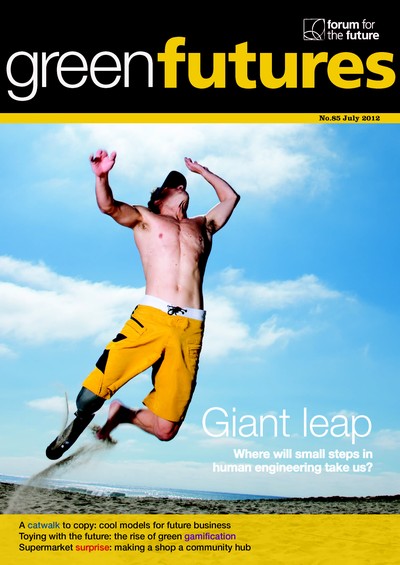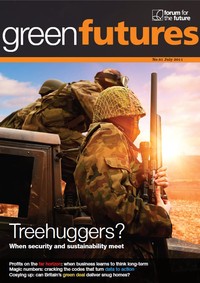Green Futures i — July 2012, #85

Green Futures
Green Futures is the leading magazine on environmental solutions and sustainable futures. Founded by Jonathon Porritt in 1996, it is published by Forum for the Future.
- 199 (51)
- United Kingdom
- Four issues a year
- First issue 1996
GBP 6.00
Over the last 12,000 years or so, human society has evolved beyond anything imaginable to our distant ancestors. We’ve developed agriculture, industry, laptops and lattes, great cities, space travel and Wifi. But we’ve remained resolutely unchanged in one respect: our bodies. They are still, to all intents and purposes, those of hunter-gatherers, perfectly honed for chasing supper across the plain and gathering nuts in May. The fact that we no longer have a hunter-gathering lifestyle, let alone diet, explains why many of us aren’t exactly optimal examples of the form. But as we’re reminded in ‘Food for the Future’, a Special Edition with this issue, trimming our insatiable appetites is only part of the answer. We also need to produce more food where it’s needed.
However, some scientists are questioning whether we can’t make ourselves more fit for (21st century) purpose. Can we design out those tiresome human frailties – like, say, the need for regular sleep, warmth (but not too much), and significant quantities of food or water? Imagine, in other words, a new body primed for a crowded, resource-constrained world. And not just the body either: we could tinker with our brains so that altruism and empathy become second nature. And if that all sounds far too Frankenstein-esque for comfort, consider the fantastic advances which have enabled this summer’s Paralympian athletes to shine [see ‘Beyond the Finish’, our second Special Edition[. Most of us would at least pause before we condemned those as unnatural. In ‘Humanity 2.0’ [p16], Carl Frankel explores just what being human could be like in the age of the bioengineer.
Of course, in some respects our ancient bodies suit modern living rather well. The opposable thumbs which evolved to grasp branches and tools are pretty handy with a games controller, and we’d never have a chance of reaching Level 4 in Call of Duty without those faculties that helped our hunting forebears ruthlessly pursue their quarry.
Just a pity they can’t be put to better use, you may think. In which case you’re probably not up to speed with all the excitement around ‘gamification’ – the application of gaming techniques to tackle everything from curing AIDS to designing green cities [‘Everything to play for’, p20].
Gaming conjures up images of the solitary teenager, zapping away in his lonely bedroom. But this is only part of the story. Increasingly, collaboration is at the heart of gaming. For all our fears about techno-solitude, we’re doing more than ever together, peer-to-peer. Small wonder, then, that some of the smartest new business ideas – ones you’ve probably heard of, like Kickstarter and Airbnb, and ones you probably haven’t, but will, such as Taskrabbit and Kiva – have peer-to-peer relationships at the heart of their logic. And they may just prove to be more sustainable too – see ‘Next year’s model’ [p32].
Seeing how things fit with and depend on each other (the heart of systems thinking) is a whole lot easier if they’re woven together through human interaction. So if models like these take off, become the norm even, we may not have to be re-engineered for altruism after all. We might be able, in Jeffrey Hollender’s words [p26], to “remap our minds”. We could learn new ways of collaboration which work for individuals as well as the group, and also for the ecosystems on which we all depend. Which, come to think of it, is more or less what our hunter-gathering ancestors did.
What do you think of this issue?
Sign up or Log in to join the discussion.
Recent activity
- 17 Sep, 2012 New cover uploaded by GreenFutures
- 17 Sep, 2012 Added to Magpile by GreenFutures



